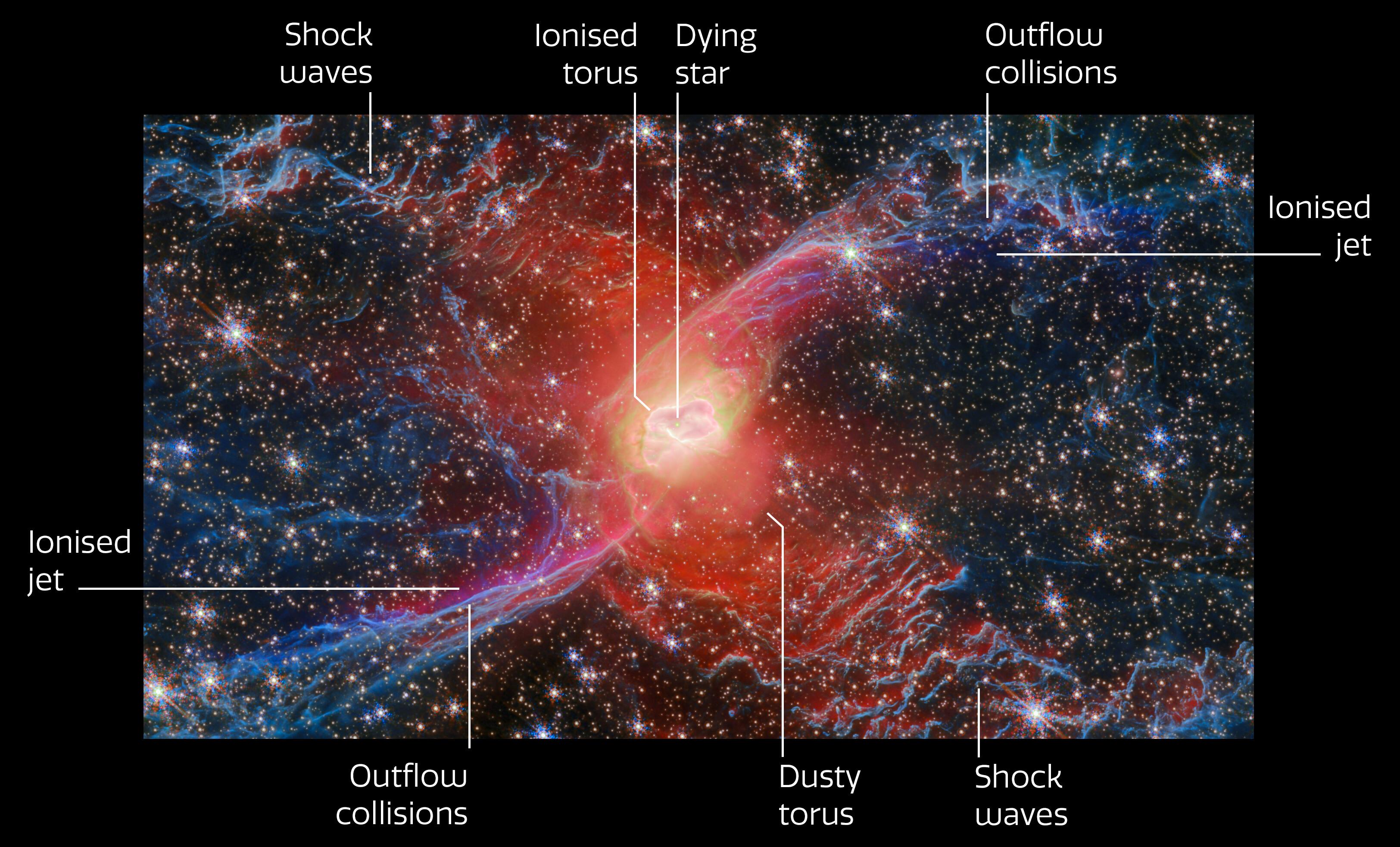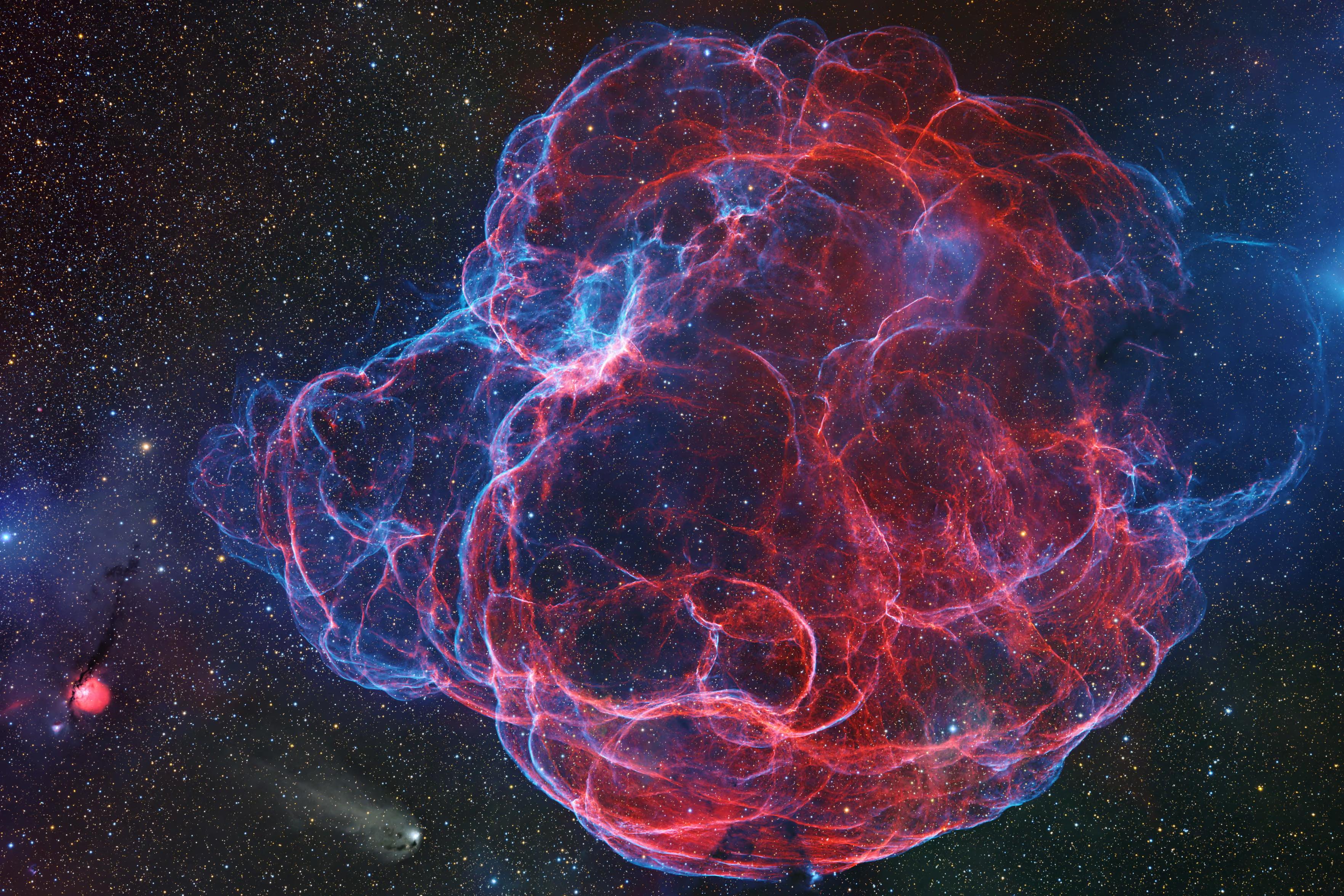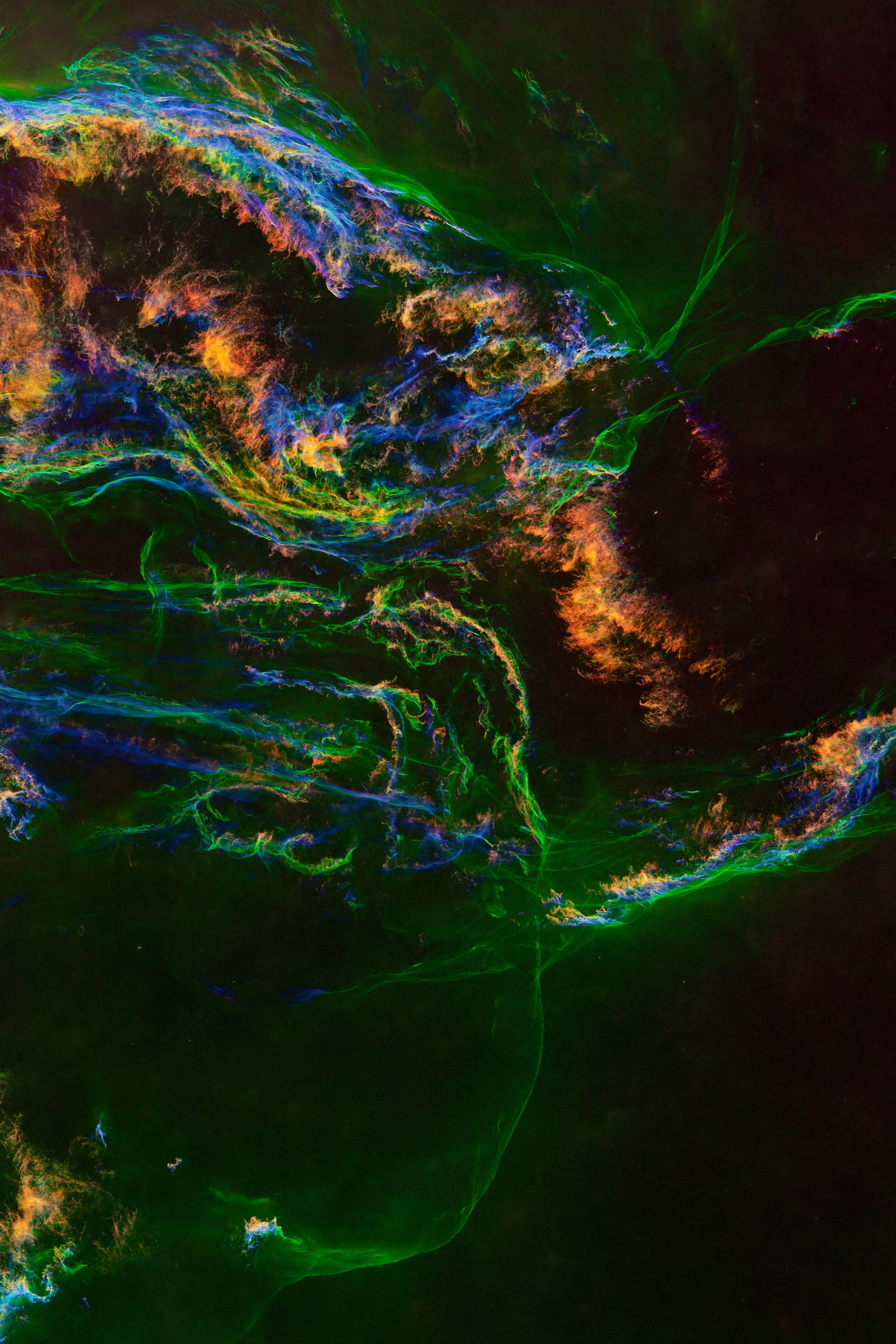The Pleiades
==========
A year after my first wide-field capture of the Pleiades, I revisited M45 with a tighter composition to reveal more of its hidden structure.
This close-up view brings out the delicate blue wisps of the reflection nebula—filaments, arcs, and soft dust clouds shaped by the hot young stars of the cluster.
With deeper integration and refined processing, this new image highlights just how intricate and dynamic the Pleiades truly are.
Scope: Askar 103APO
Lens: Askar 0.6x Reducer
Scope: Askar 103APO
Lens: Askar 0.6x Reducer
Camera: ZWO ASI 294MC Pro
Filter: Svbony UV/IR Cut
Mount: SkyWatcher AZ-EQ5-GT
Guiding: SkyWatcher Evoguide 50ED with ZWO ASI 224MC
Controller: ZWO ASIAir Pro
Focusser: ZWO EAF
Integration time: 6hrs 24min
Full version and print available at:
https://adfr.io/astro/20251122_m45/
#astrophotography #astrophoto #astrophotographer #deepsky #deepskyphotography #deepskyobject #deepskyastrophotography #nebula #deepspace #space #nightsky #astronomy #cosmos #stargazing #spaceisart #SpacePhotography #BackyardAstronomy #AstronomyLovers #starchild #cosmicwonder #spaceart #universetoday #instaastro #messier45 #m45 #pleiades #plejaden
Cat's Paw Nebula
This is my attempt at the James Webb Space Telescope data of the Cat's Paw Nebula NGC 6334. Many stars were removed or oversaturated in the filter data downloaded from MAST, resulting in a lot of artifacts in the short- and long-wavelength composite images created with #Siril. I combined both images in #GIMP and tried to fix some of the artifacts. After different tries, also on the raw data, I decided to run #StarNet++ on the combined FITS file created with GIMP and then painstakingly clean the rest (felt like 10000) of the star artifacts up. I tried to stay true to the nebula by interpolating what the area behind and around the stars most likely looks like. GIMP's heal brush worked really well, but it took many hours to complete.
The full-resolution image can be seen on my website when choosing the original size in the upper right corner (warning: it is 77 MB in size): https://www.picturavis.com/picture?/391/categories
Telescope: JWST/NIRCam
Proposal ID: 6778
Observation description: NIRCam observations of a star forming nebula
Release date: 10.07.2025
Filters: F090W (blue), F187N (light blue), F200W (blue-green), F277W (yellow-green), F335M (yellow), F444W-F470N (red)
#CatsPawNebula #NGC6334 #JWST #JamesWebb #NIRCam #Nebula #SpaceTelescope #astrophotography #DeepSky #DigiKam
The Pleiades
==========
A year after my first wide-field capture of the Pleiades, I revisited M45 with a tighter composition to reveal more of its hidden structure.
This close-up view brings out the delicate blue wisps of the reflection nebula—filaments, arcs, and soft dust clouds shaped by the hot young stars of the cluster.
With deeper integration and refined processing, this new image highlights just how intricate and dynamic the Pleiades truly are.
Scope: Askar 103APO
Lens: Askar 0.6x Reducer
Scope: Askar 103APO
Lens: Askar 0.6x Reducer
Camera: ZWO ASI 294MC Pro
Filter: Svbony UV/IR Cut
Mount: SkyWatcher AZ-EQ5-GT
Guiding: SkyWatcher Evoguide 50ED with ZWO ASI 224MC
Controller: ZWO ASIAir Pro
Focusser: ZWO EAF
Integration time: 6hrs 24min
Full version and print available at:
https://adfr.io/astro/20251122_m45/
#astrophotography #astrophoto #astrophotographer #deepsky #deepskyphotography #deepskyobject #deepskyastrophotography #nebula #deepspace #space #nightsky #astronomy #cosmos #stargazing #spaceisart #SpacePhotography #BackyardAstronomy #AstronomyLovers #starchild #cosmicwonder #spaceart #universetoday #instaastro #messier45 #m45 #pleiades #plejaden
Cat's Paw Nebula
This is my attempt at the James Webb Space Telescope data of the Cat's Paw Nebula NGC 6334. Many stars were removed or oversaturated in the filter data downloaded from MAST, resulting in a lot of artifacts in the short- and long-wavelength composite images created with #Siril. I combined both images in #GIMP and tried to fix some of the artifacts. After different tries, also on the raw data, I decided to run #StarNet++ on the combined FITS file created with GIMP and then painstakingly clean the rest (felt like 10000) of the star artifacts up. I tried to stay true to the nebula by interpolating what the area behind and around the stars most likely looks like. GIMP's heal brush worked really well, but it took many hours to complete.
The full-resolution image can be seen on my website when choosing the original size in the upper right corner (warning: it is 77 MB in size): https://www.picturavis.com/picture?/391/categories
Telescope: JWST/NIRCam
Proposal ID: 6778
Observation description: NIRCam observations of a star forming nebula
Release date: 10.07.2025
Filters: F090W (blue), F187N (light blue), F200W (blue-green), F277W (yellow-green), F335M (yellow), F444W-F470N (red)
#CatsPawNebula #NGC6334 #JWST #JamesWebb #NIRCam #Nebula #SpaceTelescope #astrophotography #DeepSky #DigiKam
Does anyone have experience with the #Nebula #streaming network?
Is it worth it?
P.S. Seems like the consensus is a resounding MEH. ;)
2025 November 20
Alnitak, Alnilam, Mintaka
* Image Credit & Copyright: Aygen Erkaslan
https://app.astrobin.com/u/a.erkaslan#gallery
Explanation:
Alnitak, Alnilam, and Mintaka are the bright bluish stars from east to west (upper right to lower left) along the diagonal in this cosmic vista. Otherwise known as the Belt of Orion, these three blue supergiant stars are hotter and much more massive than the Sun. They lie from 700 to 2,000 light-years away, born of Orion's well-studied interstellar clouds. In fact, clouds of gas and dust adrift in this region have some surprisingly familiar shapes, including the dark Horsehead Nebula and Flame Nebula near Alnitak at the upper right. The famous Orion Nebula itself is off the right edge of this colorful starfield. The telescopic frame spans almost 4 degrees on the sky.
http://stars.astro.illinois.edu/sow/alnitak.html
http://stars.astro.illinois.edu/sow/alnilam.html
http://stars.astro.illinois.edu/sow/mintaka.html
https://app.astrobin.com/u/a.erkaslan?i=6igdue#gallery
https://www.gb.nrao.edu/~rmaddale/Education/OrionTourCenter/optical.html
https://apod.nasa.gov/apod/ap200919.html
https://apod.nasa.gov/apod/ap250902.html
https://apod.nasa.gov/apod/ap251113.html
https://apod.nasa.gov/apod/ap120119.html
https://apod.nasa.gov/apod/ap251120.html
#space #nebula #astronomy #science #astrophotography #photography #nature #nebula #NASA #apod
Does anyone have experience with the #Nebula #streaming network?
Is it worth it?
P.S. Seems like the consensus is a resounding MEH. ;)
2025 November 20
Alnitak, Alnilam, Mintaka
* Image Credit & Copyright: Aygen Erkaslan
https://app.astrobin.com/u/a.erkaslan#gallery
Explanation:
Alnitak, Alnilam, and Mintaka are the bright bluish stars from east to west (upper right to lower left) along the diagonal in this cosmic vista. Otherwise known as the Belt of Orion, these three blue supergiant stars are hotter and much more massive than the Sun. They lie from 700 to 2,000 light-years away, born of Orion's well-studied interstellar clouds. In fact, clouds of gas and dust adrift in this region have some surprisingly familiar shapes, including the dark Horsehead Nebula and Flame Nebula near Alnitak at the upper right. The famous Orion Nebula itself is off the right edge of this colorful starfield. The telescopic frame spans almost 4 degrees on the sky.
http://stars.astro.illinois.edu/sow/alnitak.html
http://stars.astro.illinois.edu/sow/alnilam.html
http://stars.astro.illinois.edu/sow/mintaka.html
https://app.astrobin.com/u/a.erkaslan?i=6igdue#gallery
https://www.gb.nrao.edu/~rmaddale/Education/OrionTourCenter/optical.html
https://apod.nasa.gov/apod/ap200919.html
https://apod.nasa.gov/apod/ap250902.html
https://apod.nasa.gov/apod/ap251113.html
https://apod.nasa.gov/apod/ap120119.html
https://apod.nasa.gov/apod/ap251120.html
#space #nebula #astronomy #science #astrophotography #photography #nature #nebula #NASA #apod
My latest processing assignment for my #astrophotography class, using data from the Gateway Remote Telescope.
This is the star-forming region CG 4, known as “God’s Hand” — although as a Star Wars fan I think of it as “Millennium Falcon Escaping the Jaws of the Giant Space Slug.” It’s my favorite astro image so far and I can’t get enough of it, so here are 3 versions: a wide view, a starless image, and a tighter crop. Details in the alt text.
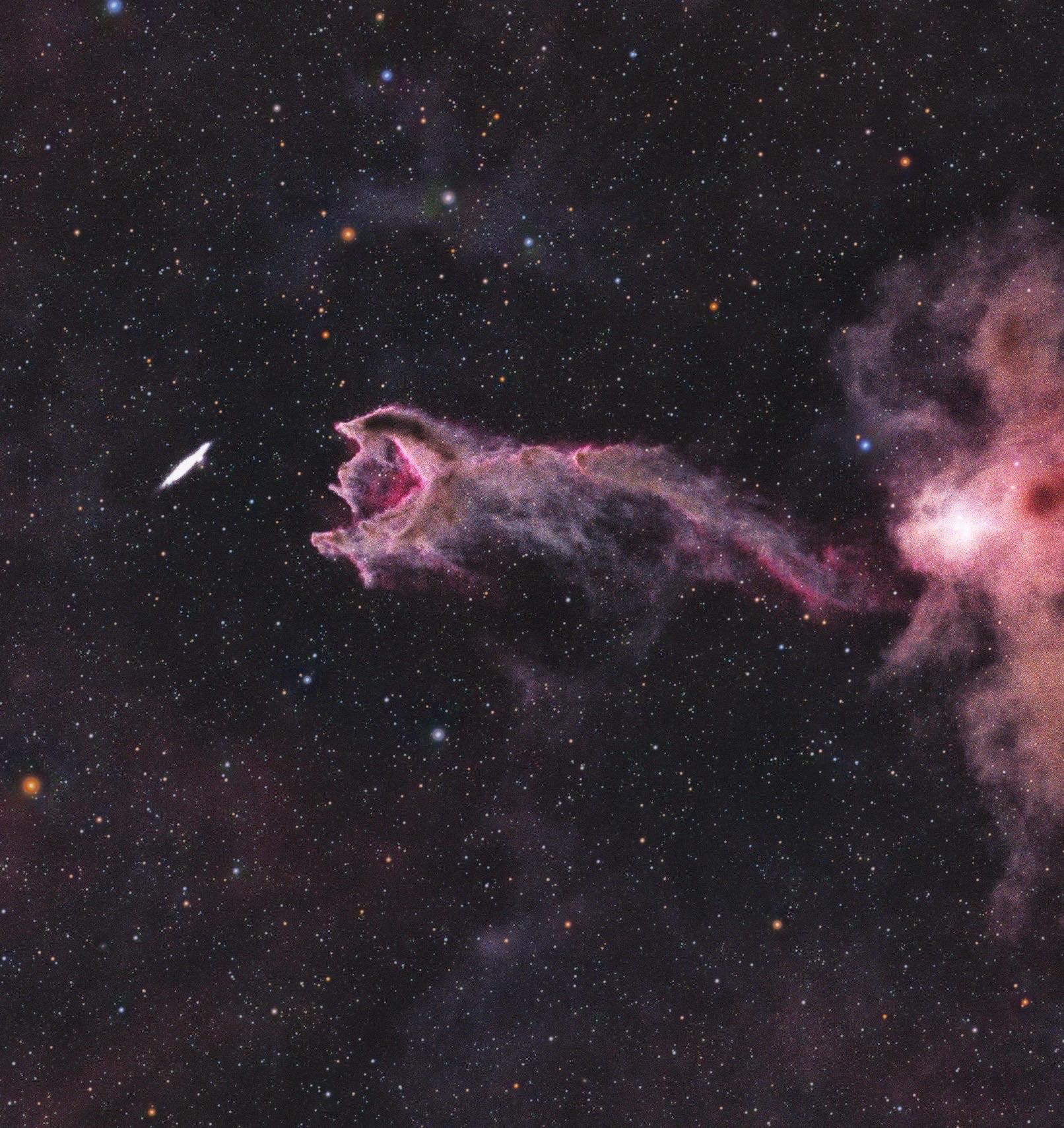

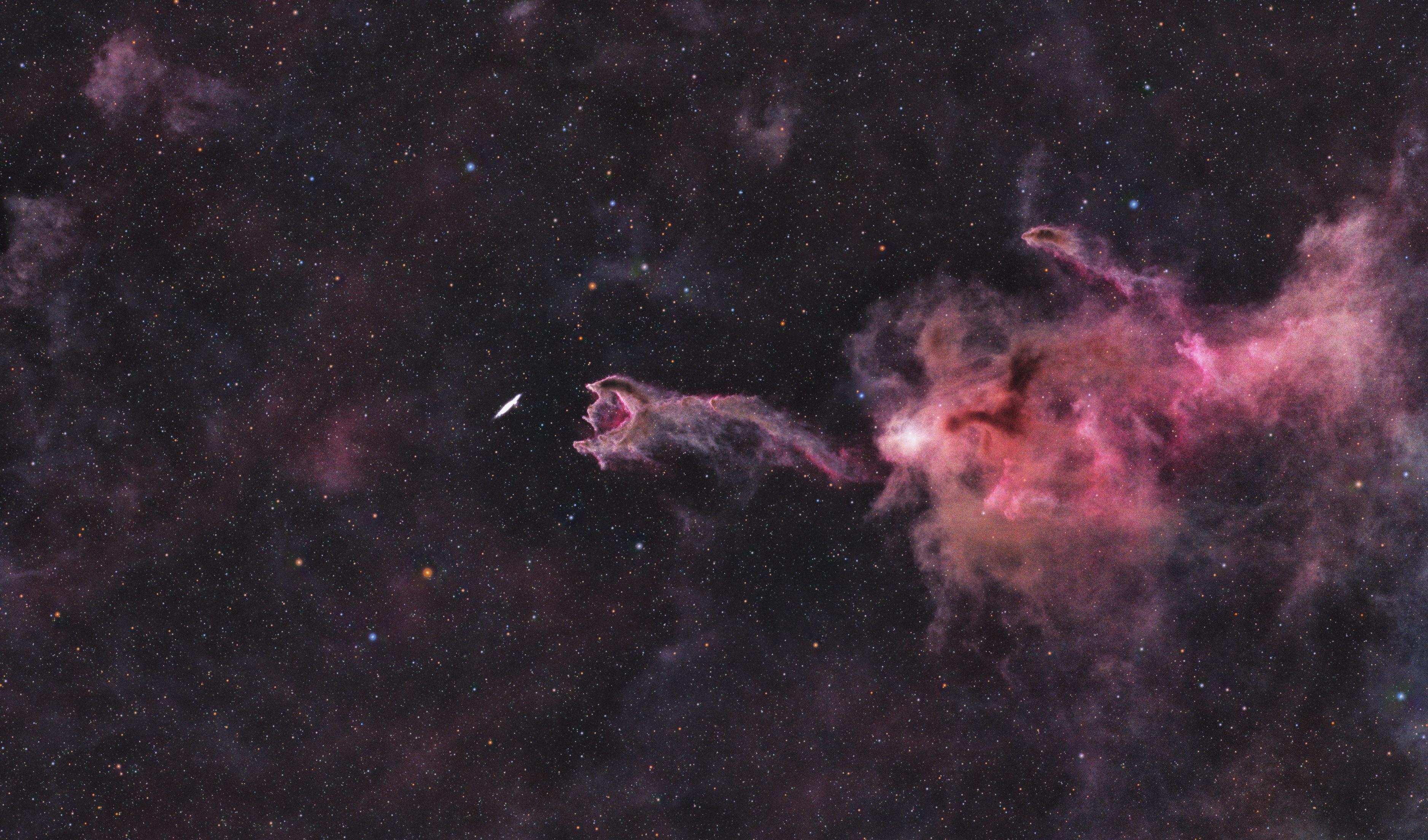
Annotated Hi-Res image for previews post.
Chamaeleon Dark Nebulas
* Image Credit & Copyright: Xinran Li & Houbo Zhou
https://apod.nasa.gov/apod/fap/ap251119.html
#space #nebula #astronomy #science #astrophotography #photography #nature #nebula #NASA #apod
2025 November 19
Chamaeleon Dark Nebulas
* Image Credit & Copyright: Xinran Li & Houbo Zhou
https://app.astrobin.com/u/Flying_Dutchman#gallery
Explanation:
Sometimes the dark dust of interstellar space has an angular elegance. Such is the case toward the far-south constellation of Chamaeleon. Normally too faint to see, dark dust is best known for blocking visible light from stars and galaxies behind it. In this 11.4-hour exposure, however, the dust is seen mostly in light of its own, with its strong red and near-infrared colors creating a brown hue. Contrastingly blue, a bright star Beta Chamaeleontis is visible on the upper right of the V, with the dust that surrounds it preferentially reflecting blue light from its primarily blue-white color. All of the pictured stars and dust occur in our own Milky Way Galaxy with one notable exception: a white spot just below Beta Chamaeleontis is the galaxy IC 3104 which lies far in the distance. Interstellar dust is mostly created in the cool atmospheres of giant stars and dispersed into space by stellar light, stellar winds, and stellar explosions such as supernovas.
https://en.wikipedia.org/wiki/Chamaeleon
https://en.wikipedia.org/wiki/Beta_Chamaeleontis
https://www.flickr.com/photos/hiroc/47807534932
http://www.werbeagentur.org/oldwexi/gallery.html
https://theskylive.com/sky/deepsky/ic3104-object
https://apod.nasa.gov/apod/ap180628.html
https://www.science.org/content/article/interstellar-dust-may-come-supernovae-after-all
https://en.wikipedia.org/wiki/List_of_stellar_explosion_types
https://en.wikipedia.org/wiki/Red_giant
https://astronomy.swin.edu.au/cosmos/d/Dust+Grain
https://apod.nasa.gov/apod/ap000318.html
https://science.nasa.gov/ems/07_infraredwaves/
https://apod.nasa.gov/apod/ap251119.html
#space #nebula #astronomy #science #astrophotography #photography #nature #nebula #NASA #apod
My latest processing assignment for my #astrophotography class, using data from the Gateway Remote Telescope.
This is the star-forming region CG 4, known as “God’s Hand” — although as a Star Wars fan I think of it as “Millennium Falcon Escaping the Jaws of the Giant Space Slug.” It’s my favorite astro image so far and I can’t get enough of it, so here are 3 versions: a wide view, a starless image, and a tighter crop. Details in the alt text.



Trapezium Zoom
Messier 42 (The Orion Nebula)
+ Distance: 1,500 light-years
+ Apparent Magnitude: 4.0
+ Constellation: Orion
+ Object Type: Nebula
+ Release Date: August 24, 2000
+ Science Release: Hubble Spies Brown Dwarfs in Nearby Stellar Nursery
Credit
Bryan Preston (STScI AVL)
https://science.nasa.gov/missions/hubble/hubble-spies-brown-dwarfs-in-nearby-stellar-nursery/
#space #nebula #astronomy #science #astrophotography #photography #nature #nebula #NASA #ESA
Messier 42 (The Orion Nebula)
* by Andrea Gianopoulos
You can spot Messier 42, better known as the Orion Nebula, with the unaided eye from a dark sky site.
Believed to be the cosmic fire of creation by the Maya of Mesoamerica, M42 blazes brightly in the constellation Orion. Popularly called the Orion Nebula, this stellar nursery has been known to many different cultures throughout human history. The nebula is only 1,500 light-years away, making it the closest large star-forming region to Earth and giving it a relatively bright apparent magnitude of 4. Because of its brightness and prominent location just below Orion’s belt, M42 can be spotted with the naked eye, while offering an excellent peek at stellar birth for those with telescopes. It is best observed during January.
The Mayan culture’s likening of the Orion Nebula to a cosmic fire of creation is very apt. The nebula is an enormous cloud of dust and gas where vast numbers of new stars are being forged. Its bright, central region is the home of four massive, young stars that shape the nebula. The four hefty stars are called the Trapezium because they are arranged in a trapezoidal pattern. Ultraviolet light unleashed by these stars is carving a cavity in the nebula and disrupting the growth of hundreds of smaller stars.
This stunning Hubble image offers the sharpest view of the Orion Nebula ever obtained. Created using 520 different Hubble exposures taken in multiple wavelengths of light, this mosaic contains over one billion pixels. Hubble imaged most of the nebula, but ground-based images were used to fill in the gaps in its observations. The orange color in the image can be attributed to hydrogen, green represents oxygen, and the red represents both sulfur and observations made in infrared light.
FYI:
https://science.nasa.gov/missions/hubble/hubble-panoramic-view-of-orion-nebula-reveals-thousands-of-stars/
https://science.nasa.gov/missions/hubble/hubble-discovery-of-runaway-star-yields-clues-to-breakup-of-multiple-star-system/
#space #nebula #astronomy #science #astrophotography #photography #nature #nebula #NASA #ESA



Hubble Spies Brown Dwarfs in Nearby Stellar Nursery
[...]
Appearing like glistening precious stones surrounding a setting of sparkling diamonds, more than 300 fledgling stars and brown dwarfs surround the brightest, most massive stars [center of picture] in Hubble's view of the Trapezium cluster's central region. All of the celestial objects in the Trapezium were born together in this hotbed of star formation. The cluster is named for the trapezoidal alignment of those central massive stars.
Brown dwarfs are gaseous objects with masses so low their cores never become hot enough to fuse hydrogen, the thermonuclear fuel stars like the Sun need to shine steadily. Instead, these gaseous objects fade and cool as they grow older. [...]
This finding, along with observations from ground-based telescopes, is further evidence that brown dwarfs, once considered exotic objects, are nearly as abundant as stars. The image and results appear in the Sept. 20 issue of the Astrophysical Journal.
The brown dwarfs are too dim to be seen in a visible-light image taken by the Hubble telescope's Wide Field and Planetary Camera 2 [picture at left]. This view also doesn't show the assemblage of infant stars seen in the near-infrared image. That's because the young stars are embedded in dense clouds of dust and gas. The Hubble telescope's near-infrared camera, the Near Infrared Camera and Multi-Object Spectrometer, penetrated those clouds to capture a view of those objects. The brown dwarfs are the faintest objects in the image. Surveying the cluster's central region, the Hubble telescope spied brown dwarfs with masses equaling 10 to 80 Jupiters. Researchers think there may be less massive brown dwarfs that are beyond the limits of Hubble's vision.
[...] (see more in ALT-text)
#space #nebula #astronomy #science #astrophot ography #photography #nature #nebula #NASA #ESA
This new annotated JWST Picture of the Month features a cosmic creepy-crawly called NGC 6537 - the Red Spider Nebula. Using its Near-InfraRed Camera (NIRCam), Webb has revealed never-before-seen details in this picturesque planetary nebula with a rich backdrop of thousands of stars.
Credit: ESA/Webb, NASA & CSA, J. H. Kastner (Rochester Institute of Technology)
https://esawebb.org/images/potm2510b/
#Astrophysics #JWST #Nebula #astrodon #space #science #stars
This new annotated JWST Picture of the Month features a cosmic creepy-crawly called NGC 6537 - the Red Spider Nebula. Using its Near-InfraRed Camera (NIRCam), Webb has revealed never-before-seen details in this picturesque planetary nebula with a rich backdrop of thousands of stars.
Credit: ESA/Webb, NASA & CSA, J. H. Kastner (Rochester Institute of Technology)
https://esawebb.org/images/potm2510b/
#Astrophysics #JWST #Nebula #astrodon #space #science #stars
Stars and nebulae, highly commended: Electric Threads by Shaoyu Zhang
This full-spectrum image of the Spaghetti nebula unveils the faint and elusive nature of this supernova remnant, hidden behind a vast cloud of dust that obstructs its emission light. To enhance its visual appeal, Shaoyu Zhang dedicated considerable time to intensifying the blue and green hues and achieving added depth.
Stars and nebulae, runner-up : Veil of Stars by Zixiong Jin
This image showcases the iconic NGC 6960, also known as the Veil nebula. To capture its intricate details and vivid colours, Zixiong Jin used a telescope, a cooled monochrome camera, an equatorial mount and a motorised filter wheel. Taken at the Marathon Sky Park in Texas last November.
Stars and nebulae, runner-up : Veil of Stars by Zixiong Jin
This image showcases the iconic NGC 6960, also known as the Veil nebula. To capture its intricate details and vivid colours, Zixiong Jin used a telescope, a cooled monochrome camera, an equatorial mount and a motorised filter wheel. Taken at the Marathon Sky Park in Texas last November.
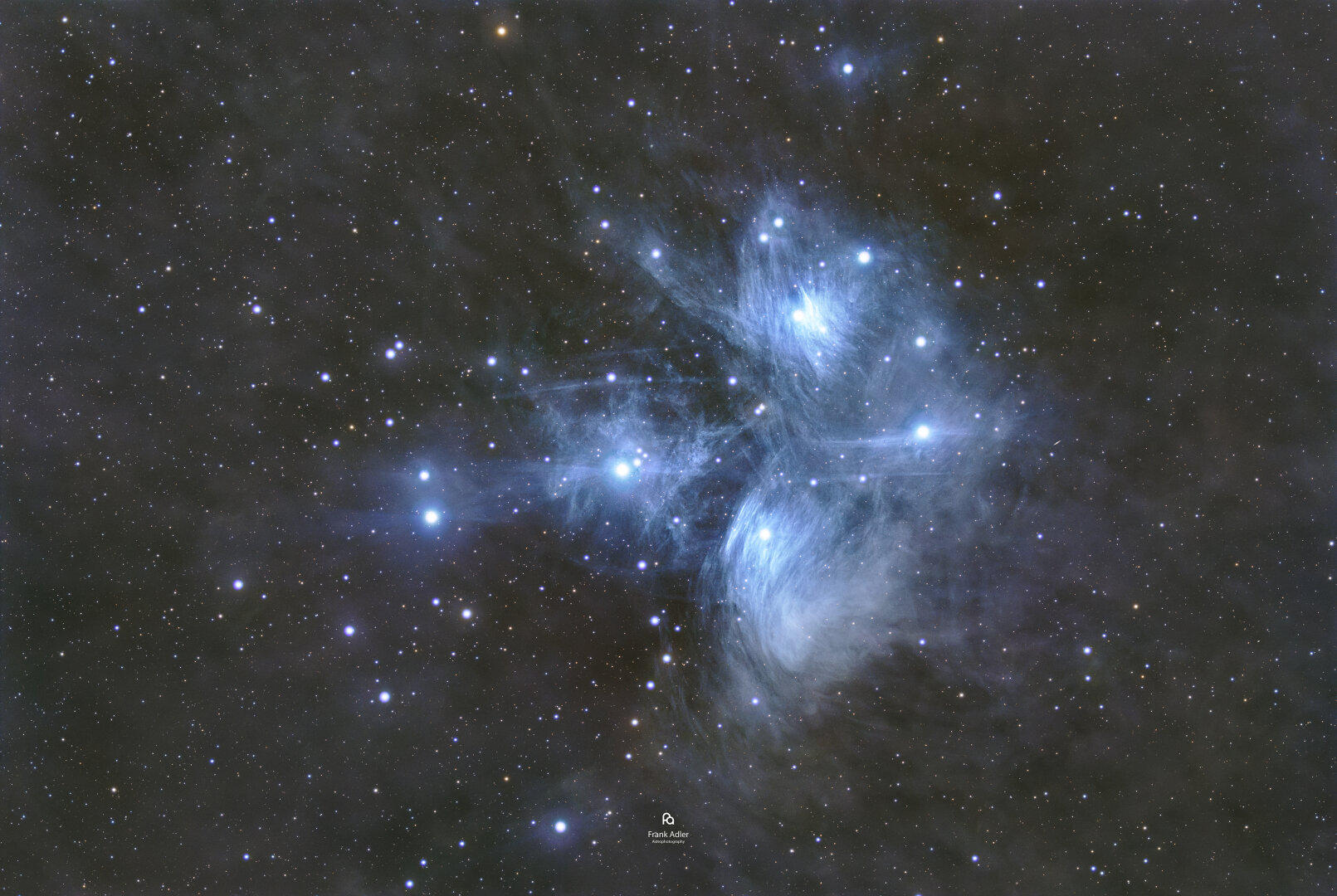
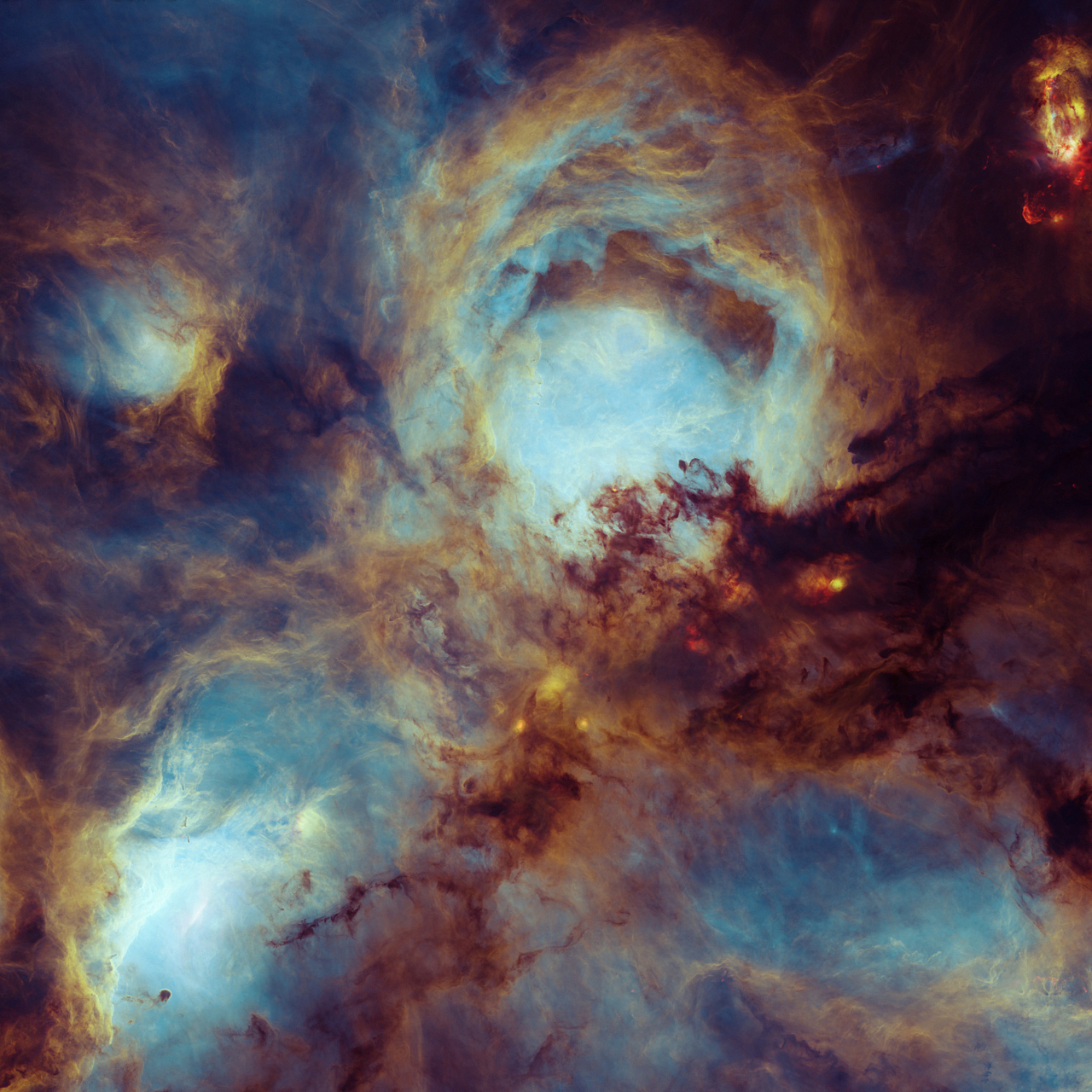





![Probing deep within a neighborhood stellar nursery, NASA's Hubble Space Telescope uncovered a swarm of newborn brown dwarfs. The orbiting observatory's near-infrared camera revealed about 50 of these objects throughout the Orion Nebula's Trapezium cluster [image at right], about 1,500 light-years from Earth. Appearing like glistening precious stones surrounding a setting of sparkling diamonds, more than 300 fledgling stars and brown dwarfs surround the brightest, most massive stars [center of picture] in Hubble's view of the Trapezium cluster's central region. The brown dwarfs are too dim to be seen in an image taken by the Hubble telescope's visible-light camera [picture at left].
[...]
The near-infrared image was taken Jan. 17, 1998. Two near-infrared filters were used to obtain information on the colors of the stars at two wavelengths (1.1 and 1.6 microns). The Trapezium picture is 1 light-year across. This composite image was made from a "mosaic" of nine separate, but adjoining images. In this false-color image, blue corresponds to warmer, more massive stars, and red to cooler, less massive stars and brown dwarfs, and stars that are heavily obscured by dust.
The visible-light data were taken in 1994 and 1995.
Credit
* Near-infrared image: NASA; K.L. Luhman and G. Schneider, E. Young, G. Rieke, A. Cotera, H. Chen, M. Rieke, R. Thompson
* Visible-light image: NASA, C.R. O'Dell and S.K. Wong (Rice University)](https://files.defcon.social/dcsocial-s3/media_attachments/files/115/552/556/134/768/487/original/5241229082ac1174.jpg)

